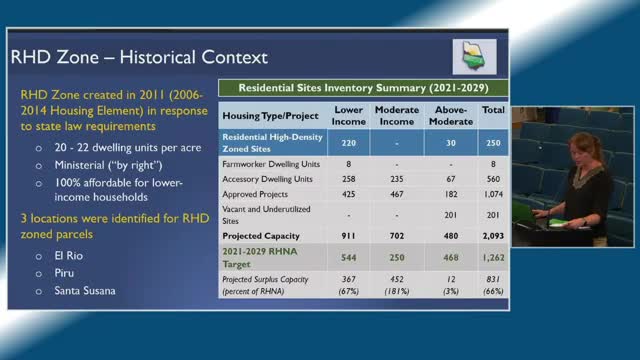County Board Updates RHD Zone Development Standards for Lower Income Housing
August 02, 2025 | Ventura County, California
This article was created by AI summarizing key points discussed. AI makes mistakes, so for full details and context, please refer to the video of the full meeting. Please report any errors so we can fix them. Report an error »

The Ventura County Resource Management Agency Planning Commission held a hearing on July 31, 2025, focusing on the development of lower-income housing in designated areas. The meeting highlighted the ongoing efforts to implement the 2011 development standards for the Residential High Density (RHD) zone, which mandates a minimum density of 20 dwelling units per acre and allows for developments to be approved without public hearings.
The RHD zone is unique in Ventura County as it is the only area where multifamily dwellings can be developed with a zoning clearance. This approach aims to reduce costs and expedite the construction of affordable housing. Currently, the RHD zone sites are projected to contribute nearly 40% of the county's overall target for lower-income housing, with an anticipated capacity of about 250 units.
The discussion included specific site locations for potential development. In El Rio, parcels 1 and 4 have the highest residential capacity and are strategically located near the city of Oxnard and a high-quality transit corridor, which promotes walkability. This area is also recognized as a disadvantaged community, making it eligible for state and federal funding aimed at equitable development.
Parcels 5 and 6, located in Santa Susana, also show significant residential capacity and are near essential services and transportation options. However, these sites are within a habitat connectivity area, requiring careful planning for any future projects.
Lastly, Parcel 7 in Piru is positioned within an urbanized area and is similarly classified as a disadvantaged community, enhancing its potential for funding opportunities.
The meeting underscored the county's commitment to addressing housing needs while promoting sustainable and equitable development in historically under-invested communities. The next steps will involve further planning and community engagement as the county moves forward with these housing initiatives.
The RHD zone is unique in Ventura County as it is the only area where multifamily dwellings can be developed with a zoning clearance. This approach aims to reduce costs and expedite the construction of affordable housing. Currently, the RHD zone sites are projected to contribute nearly 40% of the county's overall target for lower-income housing, with an anticipated capacity of about 250 units.
The discussion included specific site locations for potential development. In El Rio, parcels 1 and 4 have the highest residential capacity and are strategically located near the city of Oxnard and a high-quality transit corridor, which promotes walkability. This area is also recognized as a disadvantaged community, making it eligible for state and federal funding aimed at equitable development.
Parcels 5 and 6, located in Santa Susana, also show significant residential capacity and are near essential services and transportation options. However, these sites are within a habitat connectivity area, requiring careful planning for any future projects.
Lastly, Parcel 7 in Piru is positioned within an urbanized area and is similarly classified as a disadvantaged community, enhancing its potential for funding opportunities.
The meeting underscored the county's commitment to addressing housing needs while promoting sustainable and equitable development in historically under-invested communities. The next steps will involve further planning and community engagement as the county moves forward with these housing initiatives.
View full meeting
This article is based on a recent meeting—watch the full video and explore the complete transcript for deeper insights into the discussion.
View full meeting
